商务英语可行性报告写作格式及要求
开设商务英语专业的可行性报告

开设商务英语专业的可行性报告标题:开设商务英语专业的可行性报告引言概述:商务英语作为一门重要的专业,已经受到越来越多学生和企业的关注。
开设商务英语专业对于提高学生的英语水平、培养商务技能、满足市场需求具有重要意义。
本报告将从需求分析、市场前景、教学资源、竞争对手和专业发展方向等方面探讨开设商务英语专业的可行性。
一、需求分析1.1 学生需求:随着全球化的发展,商务英语已经成为许多企业招聘的基本要求,学生对商务英语专业的需求逐渐增加。
1.2 市场需求:随着我国对外贸易的不断扩大,商务英语专业毕业生在外贸企业、跨国公司等领域的就业需求也在增加。
1.3 社会需求:商务英语专业毕业生具备跨文化沟通能力和商务技能,能够适应国际化的商务环境,受到社会的青睐。
二、市场前景2.1 就业前景:商务英语专业毕业生在外贸、国际贸易、市场营销等领域有广阔的就业前景,薪资待遇也相对较高。
2.2 行业需求:随着我国对外贸易的不断扩大,商务英语专业毕业生的需求将会持续增加。
2.3 发展趋势:随着国际化程度的提高,商务英语专业将会成为未来教育领域的热门专业之一。
三、教学资源3.1 师资力量:开设商务英语专业需要具备一支高水平的师资队伍,包括具有丰富商务实践经验和英语教学经验的教师。
3.2 教学设施:商务英语专业需要配备现代化的教学设施,如语音实验室、多媒体教室等,以提高教学效果。
3.3 教材资源:商务英语专业需要选择与时俱进的教材,结合实际商务案例,提高学生的实践能力。
四、竞争对手4.1 同类专业:商务英语专业的竞争对手主要包括英语专业、国际贸易专业等,需要通过专业特色和教学质量来提升竞争力。
4.2 教育机构:各大高校、职业院校纷纷开设商务英语专业,需要通过不断提升教学水平和就业质量来应对竞争。
4.3 市场竞争:市场上商务英语培训机构众多,需要通过与企业合作、开展实习实践等方式来提高专业认可度。
五、专业发展方向5.1 国际化发展:商务英语专业需要与国际接轨,培养具有跨文化沟通能力和国际视野的人才。
开设商务英语专业的可行性报告
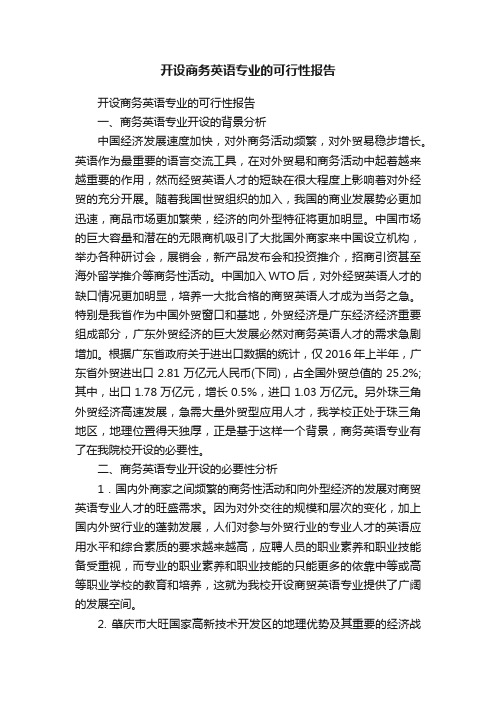
开设商务英语专业的可行性报告开设商务英语专业的可行性报告一、商务英语专业开设的背景分析中国经济发展速度加快,对外商务活动频繁,对外贸易稳步增长。
英语作为最重要的语言交流工具,在对外贸易和商务活动中起着越来越重要的作用,然而经贸英语人才的短缺在很大程度上影响着对外经贸的充分开展。
随着我国世贸组织的加入,我国的商业发展势必更加迅速,商品市场更加繁荣,经济的向外型特征将更加明显。
中国市场的巨大容量和潜在的无限商机吸引了大批国外商家来中国设立机构,举办各种研讨会,展销会,新产品发布会和投资推介,招商引资甚至海外留学推介等商务性活动。
中国加入WTO后,对外经贸英语人才的缺口情况更加明显,培养一大批合格的商贸英语人才成为当务之急。
特别是我省作为中国外贸窗口和基地,外贸经济是广东经济经济重要组成部分,广东外贸经济的巨大发展必然对商务英语人才的需求急剧增加。
根据广东省政府关于进出口数据的统计,仅2016年上半年,广东省外贸进出口2.81万亿元人民币(下同),占全国外贸总值的25.2%;其中,出口1.78万亿元,增长0.5%,进口1.03万亿元。
另外珠三角外贸经济高速发展,急需大量外贸型应用人才,我学校正处于珠三角地区,地理位置得天独厚,正是基于这样一个背景,商务英语专业有了在我院校开设的必要性。
二、商务英语专业开设的必要性分析1.国内外商家之间频繁的商务性活动和向外型经济的发展对商贸英语专业人才的旺盛需求。
因为对外交往的规模和层次的变化,加上国内外贸行业的蓬勃发展,人们对参与外贸行业的专业人才的英语应用水平和综合素质的要求越来越高,应聘人员的职业素养和职业技能备受重视,而专业的职业素养和职业技能的只能更多的依靠中等或高等职业学校的教育和培养,这就为我校开设商贸英语专业提供了广阔的发展空间。
2. 肇庆市大旺国家高新技术开发区的地理优势及其重要的经济战略地位决定其发展需要大量的商贸英语专业人才。
大旺高新区位于珠三角地区,随着珠三角地区以出口为导向的外向型经济的增长和外商投资的扩大,使得本区域内在客观上需要大批既具良好的英语语言运用能力,又熟悉国际贸易知识,有熟练国际贸易操作能力的应用型国际贸易人才,因此具备职业能力和职业素质水平较高的商贸英语专业人才将日益彰显其重要作用。
开设商务英语专业的可行性报告
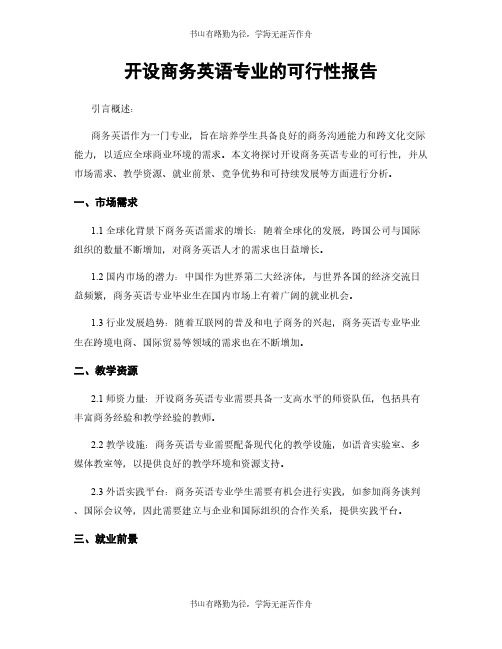
开设商务英语专业的可行性报告引言概述:商务英语作为一门专业,旨在培养学生具备良好的商务沟通能力和跨文化交际能力,以适应全球商业环境的需求。
本文将探讨开设商务英语专业的可行性,并从市场需求、教学资源、就业前景、竞争优势和可持续发展等方面进行分析。
一、市场需求1.1 全球化背景下商务英语需求的增长:随着全球化的发展,跨国公司与国际组织的数量不断增加,对商务英语人才的需求也日益增长。
1.2 国内市场的潜力:中国作为世界第二大经济体,与世界各国的经济交流日益频繁,商务英语专业毕业生在国内市场上有着广阔的就业机会。
1.3 行业发展趋势:随着互联网的普及和电子商务的兴起,商务英语专业毕业生在跨境电商、国际贸易等领域的需求也在不断增加。
二、教学资源2.1 师资力量:开设商务英语专业需要具备一支高水平的师资队伍,包括具有丰富商务经验和教学经验的教师。
2.2 教学设施:商务英语专业需要配备现代化的教学设施,如语音实验室、多媒体教室等,以提供良好的教学环境和资源支持。
2.3 外语实践平台:商务英语专业学生需要有机会进行实践,如参加商务谈判、国际会议等,因此需要建立与企业和国际组织的合作关系,提供实践平台。
三、就业前景3.1 跨国公司就业机会:商务英语专业毕业生在跨国公司中有着丰富的就业机会,可以从事国际市场开拓、跨文化交流等工作。
3.2 外贸企业就业机会:商务英语专业毕业生在外贸企业中有着广阔的就业机会,可以从事国际贸易、外贸业务管理等工作。
3.3 自主创业机会:商务英语专业毕业生具备一定的商业素养和语言能力,可以选择自主创业,开设国际贸易公司或提供商务翻译服务等。
四、竞争优势4.1 专业课程设置:商务英语专业应设置与国际贸易、商务管理等相关的专业课程,以培养学生的专业知识和实践能力。
4.2 实习机会:商务英语专业应与企业和国际组织合作,提供实习机会,使学生能够在实践中提升自己的商务技能和跨文化交际能力。
4.3 跨学科合作:商务英语专业可以与其他专业进行跨学科合作,如国际贸易、金融等,为学生提供更广阔的就业选择。
开设商务英语专业的可行性报告

开设商务英语专业的可行性报告一、背景介绍商务英语是指用英语进行商务交流和商务活动的语言技能。
随着全球化的加速发展,商务交流的需求日益增长,商务英语专业的培养成为了许多高等教育机构的重要任务之一。
本报告旨在分析开设商务英语专业的可行性,为决策者提供参考。
二、市场需求分析1. 商务英语市场潜力根据统计数据显示,全球商务英语市场规模逐年增长,预计未来几年仍将保持稳定增长。
中国作为世界第二大经济体,对商务英语人才的需求也日益增加。
开设商务英语专业能够满足市场对商务英语人才的需求,提供更多就业机会。
2. 人才需求分析目前,商务英语专业人才供给不足,市场上对商务英语人才的需求远远超过供给。
许多企业在招聘过程中都面临着找不到合适的商务英语人才的问题。
开设商务英语专业可以培养更多的商务英语人才,满足市场对人才的需求。
3. 教育市场竞争分析目前,商务英语专业在教育市场上的竞争相对较小。
虽然一些大学和职业学院已经开设了商务英语相关课程,但专业化程度较低,无法满足市场对高素质商务英语人才的需求。
开设商务英语专业可以填补市场空缺,提供更专业的商务英语教育。
三、可行性分析1. 人才培养条件开设商务英语专业需要具备一定的教学资源和条件。
需要拥有资深的商务英语教师团队,教师应具备扎实的商务英语专业知识和丰富的实践经验。
此外,还需要建立现代化的教学设施,如语言实验室、多媒体教室等,以提供良好的教学环境。
2. 课程设置和教学方法商务英语专业的课程设置应包括商务英语听说读写等方面的教学内容,注重培养学生的实际应用能力。
教学方法可以采用案例分析、角色扮演、实地考察等方式,使学生能够更好地理解和应用商务英语知识。
3. 就业前景和合作机会开设商务英语专业的学生毕业后可以在各类企事业单位从事商务英语相关工作,如国际贸易、外企、翻译公司等。
此外,还可以与企业建立合作关系,为学生提供实习和就业机会,增加就业竞争力。
四、风险与挑战1. 市场竞争风险开设商务英语专业需要面对市场上已有的商务英语相关课程和专业的竞争。
开设商务英语专业的可行性报告
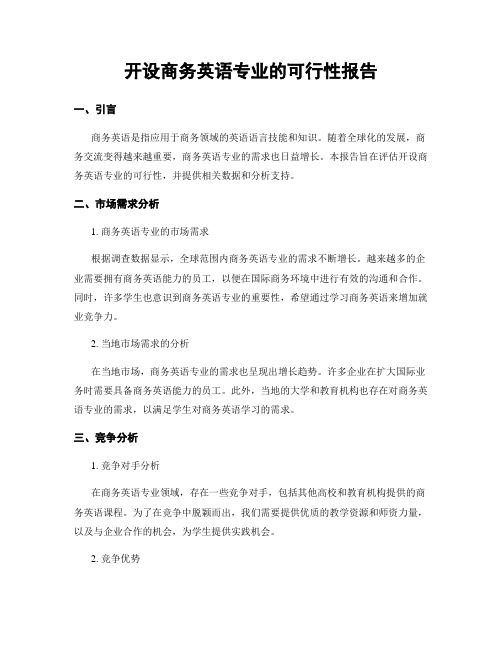
开设商务英语专业的可行性报告一、引言商务英语是指应用于商务领域的英语语言技能和知识。
随着全球化的发展,商务交流变得越来越重要,商务英语专业的需求也日益增长。
本报告旨在评估开设商务英语专业的可行性,并提供相关数据和分析支持。
二、市场需求分析1. 商务英语专业的市场需求根据调查数据显示,全球范围内商务英语专业的需求不断增长。
越来越多的企业需要拥有商务英语能力的员工,以便在国际商务环境中进行有效的沟通和合作。
同时,许多学生也意识到商务英语专业的重要性,希望通过学习商务英语来增加就业竞争力。
2. 当地市场需求的分析在当地市场,商务英语专业的需求也呈现出增长趋势。
许多企业在扩大国际业务时需要具备商务英语能力的员工。
此外,当地的大学和教育机构也存在对商务英语专业的需求,以满足学生对商务英语学习的需求。
三、竞争分析1. 竞争对手分析在商务英语专业领域,存在一些竞争对手,包括其他高校和教育机构提供的商务英语课程。
为了在竞争中脱颖而出,我们需要提供优质的教学资源和师资力量,以及与企业合作的机会,为学生提供实践机会。
2. 竞争优势我们的商务英语专业将具有以下竞争优势:- 优秀的教学资源和师资力量:拥有经验丰富、资深的商务英语教师团队,以及先进的教学设施和资源。
- 实践机会:与当地企业建立合作关系,为学生提供实践机会,增强他们的实际操作能力。
- 个性化教学:根据学生的需求和水平制定个性化的学习计划,提供定制化的教学服务。
四、资源需求分析1. 师资需求开设商务英语专业需要招聘一支经验丰富、资深的商务英语教师团队。
根据预估学生人数,需要招聘教授、副教授和讲师等不同职称的教师,以满足不同层次的教学需求。
2. 教学设施需求为了提供良好的教学环境,我们需要配备先进的教学设施,包括多媒体教室、语音实验室和图书馆等。
此外,还需要购买相关的教学资源和教材。
3. 合作机构需求为了提供实践机会,我们需要与当地企业建立合作关系。
这将需要一定的资源和时间来与企业进行洽谈和协商,以确保合作的顺利进行。
英文可行性研究报告格式

英文可行性研究报告格式1. IntroductionThis feasibility study report aims to analyze the feasibility of establishing a new coffee shop in downtown area. The report will examine various factors such as market demand, competition, location, target market, and financial projections to determine the viability of the business venture.2. BackgroundThe coffee industry has been experiencing steady growth over the past few years, with a growing consumer preference for specialty coffee beverages. The proliferation of coffee shops in urban areas highlights the potential for a new coffee shop to succeed in a competitive market. The key to success lies in offering high-quality products, excellent customer service, and a unique value proposition that sets the business apart from competitors.3. Market AnalysisThe target market for the new coffee shop will be working professionals, students, and tourists in the downtown area. Market research indicates a strong demand for coffee beverages, with consumers increasingly seeking out specialty coffees and unique flavor profiles. The presence of a diverse customer base in the downtown area presents a significant opportunity for the new coffee shop to attract and retain customers.4. Competition AnalysisThe downtown area is home to several established coffee shop chains as well as independent cafes. Competition is fierce, with each coffee shop vying for a share of the market. To differentiate itself from competitors, the new coffee shop will focus on offering a diverse menu of specialty coffee beverages, artisanal pastries, and a welcoming atmosphere that encourages customers to linger and socialize.5. Location AnalysisThe location of the new coffee shop will play a crucial role in its success. A prime location in a high-traffic area with good visibility and accessibility will attract more customers and drive sales. The ideal location should be close to office buildings, hotels, schools, and shopping centers to capture foot traffic and increase awareness of the brand.6. Financial ProjectionsFinancial projections for the new coffee shop indicate that it has the potential to generate a steady income and achieve profitability within the first year of operation. Revenue forecasts are based on projected sales volume, average ticket size, and operating expenses. The initialinvestment required to launch the business includes leasehold improvements, equipment purchases, inventory, and marketing expenses.7. ConclusionIn conclusion, the feasibility study report indicates that establishing a new coffee shop in the downtown area is a viable business opportunity. With a strong market demand for specialty coffee beverages, a competitive analysis that identifies opportunities for differentiation, a strategic location, and sound financial projections, the new coffee shop has the potential to succeed and thrive in a competitive market. Further research and planning are needed to refine the business model, develop a comprehensive marketing strategy, and secure funding to launch the business successfully.。
开设商务英语专业的可行性报告

开设商务英语专业的可行性报告一、引言商务英语是指用英语进行商务活动和交流的语言能力。
随着全球经济的不断发展和国际化程度的提高,商务英语的需求日益增长。
本报告旨在评估开设商务英语专业的可行性,并提供相关数据和分析,以支持决策过程。
二、市场需求分析1. 商务英语的市场需求根据调查数据显示,全球范围内商务英语的需求呈现稳定增长的趋势。
越来越多的企业和组织需要拥有良好的商务英语沟通能力,以应对国际贸易、跨国合作和市场拓展等挑战。
同时,随着中国经济的快速发展,国内企业对商务英语人才的需求也在不断增加。
2. 市场竞争情况目前,国内外已有一些高校和培训机构开设商务英语相关专业或课程。
然而,大部分商务英语专业的教育模式仍然停留在传统的课堂教学和书本知识传授上,缺乏实践和应用能力的培养。
因此,开设一门注重实践和应用的商务英语专业具有一定的市场竞争力。
三、可行性分析1. 教育资源开设商务英语专业需要充足的教育资源,包括教师团队、教材、教学设施等。
通过与国内外知名高校和企业合作,可以引进优质的教育资源,提高教学质量。
2. 就业前景商务英语专业毕业生具有很好的就业前景。
根据市场调研数据显示,商务英语人才在国内外企业中的需求量大,薪资待遇也相对较高。
开设商务英语专业可以为学生提供更多就业机会和发展空间。
3. 教学模式创新为了提高教学质量和培养学生的实践能力,可以引入创新的教学模式,如项目式教学、实践案例分析等。
通过与企业合作,开展实践项目和实习,使学生能够在实际商务环境中应用所学知识。
四、开设商务英语专业的建议1. 课程设置商务英语专业的课程设置应包括基础课程和专业课程。
基础课程包括英语语言基础、商务知识和跨文化交际等。
专业课程包括商务英语写作、口语交流、商务谈判等。
同时,可以设置选修课程,以满足学生个性化的需求。
2. 师资队伍建设拥有高水平的师资队伍是保证教学质量的重要因素。
建议通过引进国内外优秀教师、培训师和行业专家,提高教师的教学水平和实践经验。
开设商务英语专业的可行性报告

开设商务英语专业的可行性报告商务英语专业可行性报告一、引言商务英语专业是指培养具备商务英语专业知识和技能,能在国际商务交流中进行有效沟通和协商的人才。
本报告旨在评估开设商务英语专业的可行性,包括市场需求、竞争分析、教育资源、就业前景等方面的考虑。
二、市场需求分析1. 市场规模:根据调查数据显示,全球商务英语市场规模逐年增长,预计未来几年仍将保持稳定增长。
2. 行业需求:随着全球化进程的加速,跨国公司和国内企业对商务英语人才的需求不断增加,特别是在国际贸易、国际市场拓展等领域。
3. 学生需求:大量学生对商务英语专业的需求旺盛,希望通过专业学习提升自己的英语水平,并增加就业竞争力。
三、竞争分析1. 竞争对手:目前市场上已经存在一些商务英语专业的培训机构和大学,它们提供类似的课程和教学资源。
2. 竞争优势:通过与竞争对手的比较,我们可以发现开设商务英语专业的优势在于教学资源的丰富性、师资力量的强大性以及与企业的合作关系等方面。
四、教育资源1. 师资力量:商务英语专业需要拥有一支高素质的教师队伍,具备丰富的商务英语教学经验和实践经验。
2. 教学设施:开设商务英语专业需要提供良好的教学设施,包括现代化的教室、多媒体设备和图书馆等。
五、课程设置1. 专业核心课程:商务英语专业的核心课程包括商务英语听说读写、商务沟通技巧、国际贸易、国际市场营销等。
2. 选修课程:根据学生的个人兴趣和职业需求,设置一定数量的选修课程,如国际商务谈判、跨文化交流等。
六、就业前景1. 就业市场:商务英语专业毕业生可以在跨国公司、外贸企业、金融机构、翻译公司等领域就业,就业市场广阔。
2. 薪资待遇:商务英语专业毕业生的薪资待遇相对较高,特别是在国际化程度较高的企业。
七、市场推广策略1. 品牌建设:通过打造专业形象、提供优质的教学服务,树立良好的品牌形象。
2. 宣传推广:利用互联网、社交媒体等渠道进行宣传推广,吸引更多学生的关注和报名。
开设商务英语专业的可行性报告
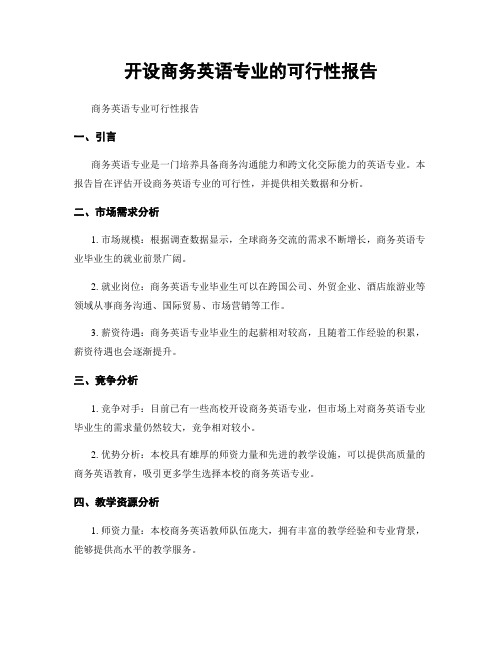
开设商务英语专业的可行性报告商务英语专业可行性报告一、引言商务英语专业是一门培养具备商务沟通能力和跨文化交际能力的英语专业。
本报告旨在评估开设商务英语专业的可行性,并提供相关数据和分析。
二、市场需求分析1. 市场规模:根据调查数据显示,全球商务交流的需求不断增长,商务英语专业毕业生的就业前景广阔。
2. 就业岗位:商务英语专业毕业生可以在跨国公司、外贸企业、酒店旅游业等领域从事商务沟通、国际贸易、市场营销等工作。
3. 薪资待遇:商务英语专业毕业生的起薪相对较高,且随着工作经验的积累,薪资待遇也会逐渐提升。
三、竞争分析1. 竞争对手:目前已有一些高校开设商务英语专业,但市场上对商务英语专业毕业生的需求量仍然较大,竞争相对较小。
2. 优势分析:本校具有雄厚的师资力量和先进的教学设施,可以提供高质量的商务英语教育,吸引更多学生选择本校的商务英语专业。
四、教学资源分析1. 师资力量:本校商务英语教师队伍庞大,拥有丰富的教学经验和专业背景,能够提供高水平的教学服务。
2. 教学设施:本校拥有先进的语音实验室、多媒体教室等教学设施,能够提供良好的学习环境。
五、课程设置1. 基础课程:商务英语专业的基础课程包括英语语言基础、商务沟通、国际贸易等内容,旨在培养学生的语言能力和商务素养。
2. 专业课程:商务英语专业的专业课程包括商务英语写作、商务口语、国际市场营销等内容,旨在培养学生的专业技能和实践能力。
3. 实习实训:商务英语专业将设置实习实训环节,让学生在实际工作中锻炼和应用所学知识。
六、招生计划1. 招生人数:根据市场需求和教学资源,初期拟招收100名学生,逐年增加招生规模。
2. 招生对象:对英语基础较好、对商务领域有兴趣的高中毕业生进行招生。
七、预期效益分析1. 学生就业率:商务英语专业毕业生的就业率较高,预计能够为社会培养大量优秀的商务人才。
2. 学校声誉提升:开设商务英语专业将提升学校在商务教育领域的声誉,吸引更多优秀的学生报考本校。
开设商务英语专业的可行性报告

开设商务英语专业的可行性报告商务英语专业可行性报告一、引言商务英语专业是一门旨在培养学生具备商务沟通能力和跨文化交际能力的专业。
本报告旨在评估开设商务英语专业的可行性,包括市场需求、竞争分析、教学资源和运营成本等方面的考虑。
二、市场需求分析1. 商务英语在全球化背景下的重要性:随着全球化的发展,商务交流日益频繁。
跨国公司、国际贸易和旅游业等行业对于掌握商务英语的人才需求量大。
2. 市场潜力:根据市场调研数据显示,目前商务英语培训市场规模庞大,但供给不足,存在着较大的市场空缺。
三、竞争分析1. 竞争对手分析:目前市场上存在一些商务英语培训机构,如ABC商务英语学校和XYZ商务英语培训中心。
这些机构的优势在于多年的经验和广泛的学生网络。
2. 我们的竞争优势:我们将提供全面的商务英语课程,强调实践应用和跨文化交际能力培养。
此外,我们将与企业合作,提供实习和就业机会,以增加学生的竞争力。
四、教学资源1. 教师团队:我们将聘请经验丰富、资质优秀的商务英语教师,他们具备良好的教学能力和实践经验。
2. 教学设施:我们将提供先进的教学设施,包括多媒体教室、语音实验室和图书馆等,以提供良好的学习环境。
五、运营成本1. 人力资源:我们将雇佣教师、行政人员和市场推广人员等,以确保学校正常运营。
人力资源成本将是我们的主要开支。
2. 教学设施和设备:我们需要投资于教学设施和设备的购置和维护,以提供良好的教学环境。
3. 市场推广费用:为了吸引学生,我们将进行市场推广活动,包括广告宣传、线上推广和合作伙伴关系建立等。
六、预期效益1. 学生就业率提高:商务英语专业的开设将提高学生的就业竞争力,为他们在跨国公司和国际贸易等行业找到更好的就业机会。
2. 学校声誉提升:商务英语专业的成功开设将提升学校在商务教育领域的声誉,吸引更多学生报考。
七、结论综上所述,开设商务英语专业是可行的。
市场需求大,竞争对手相对较少,我们具备教学资源和运营成本的能力。
开设商务英语专业的可行性报告
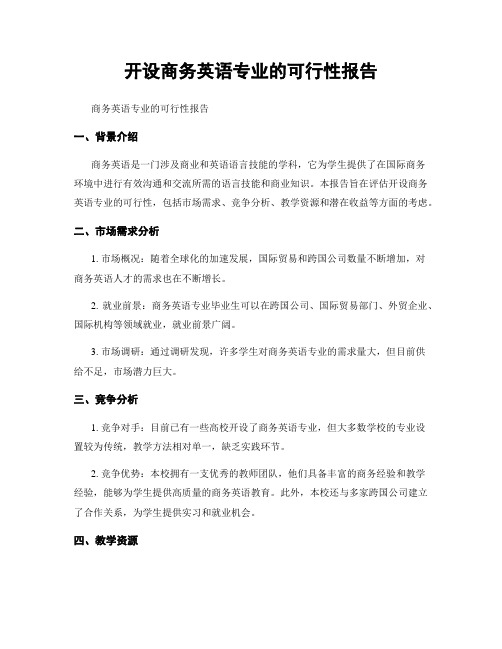
开设商务英语专业的可行性报告商务英语专业的可行性报告一、背景介绍商务英语是一门涉及商业和英语语言技能的学科,它为学生提供了在国际商务环境中进行有效沟通和交流所需的语言技能和商业知识。
本报告旨在评估开设商务英语专业的可行性,包括市场需求、竞争分析、教学资源和潜在收益等方面的考虑。
二、市场需求分析1. 市场概况:随着全球化的加速发展,国际贸易和跨国公司数量不断增加,对商务英语人才的需求也在不断增长。
2. 就业前景:商务英语专业毕业生可以在跨国公司、国际贸易部门、外贸企业、国际机构等领域就业,就业前景广阔。
3. 市场调研:通过调研发现,许多学生对商务英语专业的需求量大,但目前供给不足,市场潜力巨大。
三、竞争分析1. 竞争对手:目前已有一些高校开设了商务英语专业,但大多数学校的专业设置较为传统,教学方法相对单一,缺乏实践环节。
2. 竞争优势:本校拥有一支优秀的教师团队,他们具备丰富的商务经验和教学经验,能够为学生提供高质量的商务英语教育。
此外,本校还与多家跨国公司建立了合作关系,为学生提供实习和就业机会。
四、教学资源1. 师资力量:本校商务英语专业将聘请具有丰富教学经验和商务背景的教师担任主讲教师,并邀请国内外商务专家担任客座教授,以提高教学质量。
2. 教学设施:学校将投入资金建设现代化的语言实验室、多媒体教室和商务模拟实训中心,以提供良好的教学环境和实践机会。
3. 教材和课程:根据市场需求和教学目标,本校将编写符合国际商务标准的教材,并设计实用的课程,注重培养学生的语言技能和商业素养。
五、潜在收益1. 学费收入:开设商务英语专业将增加学校的学费收入,随着学生数量的增加,学校的财务状况将得到改善。
2. 合作机会:与跨国公司合作,为学生提供实习和就业机会,进一步增加学校的知名度和影响力。
3. 国际交流:开设商务英语专业将吸引更多国际学生来校学习,促进学校与国外高校的交流与合作。
六、风险与挑战1. 市场风险:市场需求的变化可能会影响商务英语专业的招生情况,需要密切关注市场动态并及时调整课程设置。
商务英语商务报告格式范文(推荐19篇)

商务英语商务报告格式范文(推荐19篇)(经典版)编制人:__________________审核人:__________________审批人:__________________编制单位:__________________编制时间:____年____月____日序言下载提示:该文档是本店铺精心编制而成的,希望大家下载后,能够帮助大家解决实际问题。
文档下载后可定制修改,请根据实际需要进行调整和使用,谢谢!并且,本店铺为大家提供各种类型的经典范文,如工作总结、工作计划、合同协议、条据文书、策划方案、句子大全、作文大全、诗词歌赋、教案资料、其他范文等等,想了解不同范文格式和写法,敬请关注!Download tips: This document is carefully compiled by this editor. I hope that after you download it, it can help you solve practical problems. The document can be customized and modified after downloading, please adjust and use it according to actual needs, thank you!Moreover, our store provides various types of classic sample essays for everyone, such as work summaries, work plans, contract agreements, doctrinal documents, planning plans, complete sentences, complete compositions, poems, songs, teaching materials, and other sample essays. If you want to learn about different sample formats and writing methods, please stay tuned!商务英语商务报告格式范文(推荐19篇) 商务英语商务报告格式范文第1篇入世后,经济全球化、市场国际化的进一步深化,各个领域都离不开英语人才,尤其是既懂商业贸易、市场营销、经济管理,又精通英语的复合型人才更是紧缺,商贸英语人才已成为各行业、各领域的骨干人才、通用人才。
开设商务英语专业的可行性报告
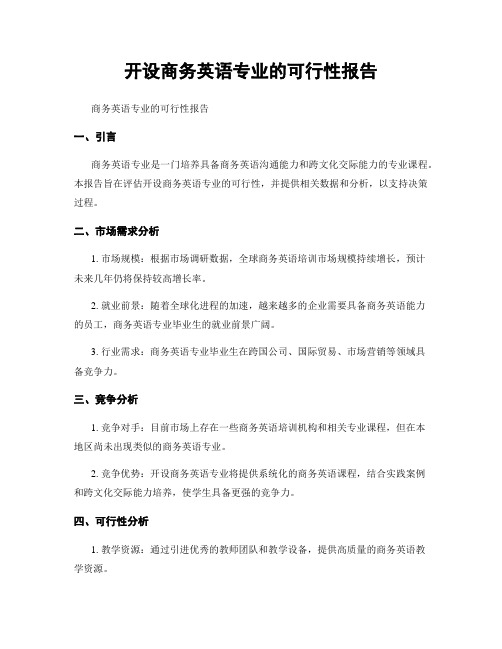
开设商务英语专业的可行性报告商务英语专业的可行性报告一、引言商务英语专业是一门培养具备商务英语沟通能力和跨文化交际能力的专业课程。
本报告旨在评估开设商务英语专业的可行性,并提供相关数据和分析,以支持决策过程。
二、市场需求分析1. 市场规模:根据市场调研数据,全球商务英语培训市场规模持续增长,预计未来几年仍将保持较高增长率。
2. 就业前景:随着全球化进程的加速,越来越多的企业需要具备商务英语能力的员工,商务英语专业毕业生的就业前景广阔。
3. 行业需求:商务英语专业毕业生在跨国公司、国际贸易、市场营销等领域具备竞争力。
三、竞争分析1. 竞争对手:目前市场上存在一些商务英语培训机构和相关专业课程,但在本地区尚未出现类似的商务英语专业。
2. 竞争优势:开设商务英语专业将提供系统化的商务英语课程,结合实践案例和跨文化交际能力培养,使学生具备更强的竞争力。
四、可行性分析1. 教学资源:通过引进优秀的教师团队和教学设备,提供高质量的商务英语教学资源。
2. 学生招生:根据市场需求和竞争分析,预计能够吸引足够数量的学生报读商务英语专业。
3. 教学质量保障:建立完善的教学质量评估体系,提供个性化的学习辅导和实践机会,确保学生的学习效果和满意度。
4. 资金投入:根据市场调研数据和预测,商务英语专业的开设将需要一定的资金投入,但预计能够在合理的时间内实现回报。
五、实施计划1. 课程设置:商务英语专业的课程设置应包括商务英语听说读写能力培养、商务文化与礼仪、国际商务沟通等相关课程。
2. 师资培养:招聘具有商务英语教学经验和跨文化交际能力的教师,定期进行培训和进修,提升教学水平。
3. 实践机会:与企业合作,提供实习和实践机会,帮助学生将所学理论知识应用到实际工作中。
4. 宣传推广:利用多种渠道进行宣传推广,包括校园宣传、社交媒体、合作伙伴推荐等,吸引更多学生报读商务英语专业。
六、风险评估1. 市场竞争风险:可能会面临其他商务英语培训机构的竞争,需提供更优质的教学内容和服务,以吸引学生。
开设商务英语专业的可行性报告
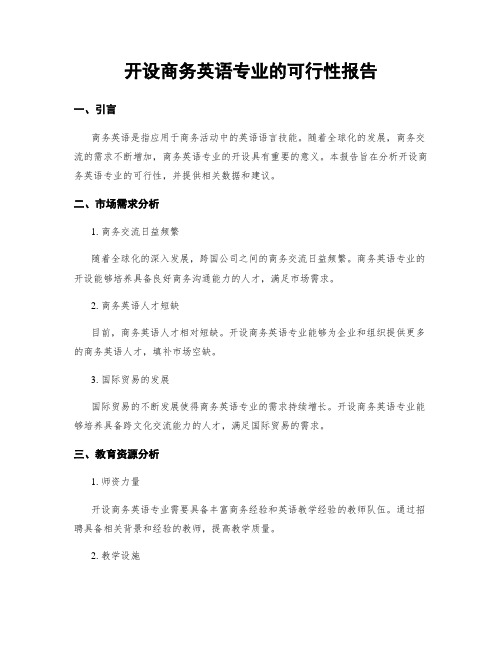
开设商务英语专业的可行性报告一、引言商务英语是指应用于商务活动中的英语语言技能。
随着全球化的发展,商务交流的需求不断增加,商务英语专业的开设具有重要的意义。
本报告旨在分析开设商务英语专业的可行性,并提供相关数据和建议。
二、市场需求分析1. 商务交流日益频繁随着全球化的深入发展,跨国公司之间的商务交流日益频繁。
商务英语专业的开设能够培养具备良好商务沟通能力的人才,满足市场需求。
2. 商务英语人才短缺目前,商务英语人才相对短缺。
开设商务英语专业能够为企业和组织提供更多的商务英语人才,填补市场空缺。
3. 国际贸易的发展国际贸易的不断发展使得商务英语专业的需求持续增长。
开设商务英语专业能够培养具备跨文化交流能力的人才,满足国际贸易的需求。
三、教育资源分析1. 师资力量开设商务英语专业需要具备丰富商务经验和英语教学经验的教师队伍。
通过招聘具备相关背景和经验的教师,提高教学质量。
2. 教学设施商务英语专业需要配备现代化的教学设施,包括语音实验室、多媒体教室和图书馆等。
投入足够的资金和资源,提供良好的学习环境。
四、可行性分析1. 市场前景广阔商务英语专业的开设能够满足市场需求,培养更多的商务英语人才。
随着全球化的深入发展,商务交流的需求将持续增长,市场前景广阔。
2. 教育资源充足学校具备丰富的师资力量和现代化的教学设施,能够支持商务英语专业的开设和教学活动。
3. 就业机会丰富商务英语专业的学生毕业后可以在跨国公司、国际贸易机构、外企和翻译公司等领域就业。
就业机会丰富,能够提供稳定的职业发展。
五、建议与措施1. 专业课程设置根据市场需求和学生需求,合理设置商务英语专业的课程,包括商务沟通、商务写作、国际贸易等方面的课程。
2. 实践教学加强商务英语专业的实践教学环节,组织学生参加商务实习、模拟商务谈判等活动,提升学生的实际应用能力。
3. 与企业合作与跨国公司、国际贸易机构等企业合作,开展实践项目和实习机会,为学生提供更多的实践机会和就业渠道。
开设商务英语专业的可行性报告
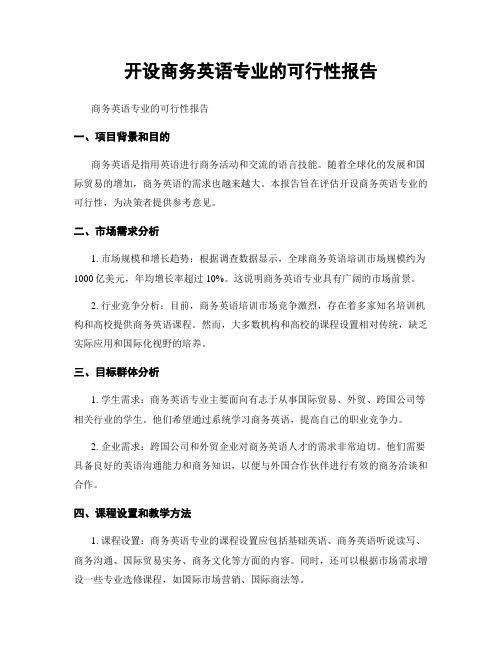
开设商务英语专业的可行性报告商务英语专业的可行性报告一、项目背景和目的商务英语是指用英语进行商务活动和交流的语言技能。
随着全球化的发展和国际贸易的增加,商务英语的需求也越来越大。
本报告旨在评估开设商务英语专业的可行性,为决策者提供参考意见。
二、市场需求分析1. 市场规模和增长趋势:根据调查数据显示,全球商务英语培训市场规模约为1000亿美元,年均增长率超过10%。
这说明商务英语专业具有广阔的市场前景。
2. 行业竞争分析:目前,商务英语培训市场竞争激烈,存在着多家知名培训机构和高校提供商务英语课程。
然而,大多数机构和高校的课程设置相对传统,缺乏实际应用和国际化视野的培养。
三、目标群体分析1. 学生需求:商务英语专业主要面向有志于从事国际贸易、外贸、跨国公司等相关行业的学生。
他们希望通过系统学习商务英语,提高自己的职业竞争力。
2. 企业需求:跨国公司和外贸企业对商务英语人才的需求非常迫切。
他们需要具备良好的英语沟通能力和商务知识,以便与外国合作伙伴进行有效的商务洽谈和合作。
四、课程设置和教学方法1. 课程设置:商务英语专业的课程设置应包括基础英语、商务英语听说读写、商务沟通、国际贸易实务、商务文化等方面的内容。
同时,还可以根据市场需求增设一些专业选修课程,如国际市场营销、国际商法等。
2. 教学方法:商务英语专业应采用多元化的教学方法,包括课堂教学、案例分析、模拟商务活动、实地考察等。
通过实际案例和实践操作,提高学生的实际应用能力和跨文化交际能力。
五、师资和教学资源1. 师资力量:商务英语专业需要具备良好的英语水平和丰富的商务经验的教师团队。
他们应具备扎实的语言基础和丰富的实践经验,能够结合实际案例进行教学。
2. 教学资源:商务英语专业需要配备先进的教学设备和资源,包括多媒体教室、语音实验室、商务资讯数据库等。
同时,还可以与企业合作,提供实习机会和实际案例资源。
六、市场推广和合作机会1. 市场推广:可以通过校园宣传、线上线下广告、合作推广等方式进行市场推广。
开设商务英语专业的可行性报告

开设商务英语专业的可行性报告Title: Feasibility Report for the Establishment of a Business English Major1. IntroductionThe purpose of this feasibility report is to analyze the viability of introducing a Business English major at our institution. This report outlines the potential benefits, target market, potential challenges, and steps required for successful implementation.2. Background3. Potential Benefitsc) Industry Collaboration: A Business English major will encourage collaboration with local businesses, enabling students to gain practical exposure through internships, partnerships, and guest speaker sessions.d) Future Growth: As the demand for English language skills in the business world continues to rise, this major will ensure our institution stays relevant and meets the needs of the evolving job market.4. Target MarketThe target market for the Business English major includes:a) Undergraduate students with an interest in business and international trade.c) International students who aim to improve their English proficiency in a business context.5. Potential Challengesa) Faculty Expertise: Hiring qualified faculty withexcellent language skills and a solid understanding of the business world may pose a challenge. Collaboration with industry experts and utilizing visiting professors can help address this issue.b) Curriculum Design: Developing a curriculum that balances both language proficiency and business knowledge may require additional research and consultation with professionals in the field.c) Marketing and Recruitment: Effective marketing strategies will be necessary to attract potential students and promote the uniqueness of the Business English major.6. Implementation Planb) Faculty Recruitment: Conduct a thorough search to recruit qualified faculty with a solid background in both English language education and business.c) Partnerships: Collaborate with local businesses, industry associations, and international organizations to provideinternships, guest lectures, and real-world projects for students.d) Marketing and Promotion: Develop targeted marketing campaigns that highlight the advantages of the Business English major to attract students at the undergraduate and professional levels.7. Conclusion。
开设商务英语专业的可行性报告

开设商务英语专业的可行性报告标题:开设商务英语专业的可行性报告
引言概述:
商务英语是指在商务领域中使用英语进行交流和沟通的一种特殊语言能力。
随着全球化的发展,商务英语在国际贸易、跨国公司、金融机构等领域中越来越重要。
因此,开设商务英语专业具有重要的意义和可行性。
一、市场需求
1.1 全球化背景下商务英语需求增加
1.2 跨国公司对商务英语人材的需求
1.3 金融、贸易等行业对商务英语专业人材的需求
二、教育资源
2.1 专业教师团队的建设
2.2 教学设施和资源的支持
2.3 与企业合作的机会和资源
三、课程设置
3.1 商务英语基础课程
3.2 商务沟通技巧课程
3.3 商务实践和案例分析课程
四、就业前景
4.1 跨国公司、金融机构等企业的用人需求
4.2 商务英语专业毕业生的就业竞争力
4.3 就业薪资和发展空间
五、发展前景
5.1 商务英语专业的未来发展趋势
5.2 国内外商务英语专业的发展状况
5.3 商务英语专业的可持续发展
结论:
综上所述,开设商务英语专业具有明显的市场需求、教育资源支持、课程设置优势、就业前景广阔和发展潜力巨大。
因此,开设商务英语专业是可行的,有利于培养符合国际商务需求的高素质人材,推动我国商务英语教育事业的发展。
开设商务英语专业的可行性报告

开设商务英语专业的可行性报告标题:商务英语专业的可行性报告
引言概述:
商务英语作为一门专业,其可行性是值得深入研究的。
本文将从市场需求、教育资源、就业前景、专业设置和竞争优势等方面进行分析,以探讨开设商务英语专业的可行性。
一、市场需求
1.1 全球化趋势下商务英语的重要性
1.2 企业对商务英语人才的需求
1.3 市场对商务英语专业的潜在需求
二、教育资源
2.1 师资力量的保障
2.2 教学设施和教材的支持
2.3 实践机会的提供
三、就业前景
3.1 商务英语专业的就业市场
3.2 跨国公司和外企的招聘需求
3.3 创业机会和自主发展空间
四、专业设置
4.1 课程设置的合理性
4.2 实践环节的完善性
4.3 与其他相关专业的协同发展
五、竞争优势
5.1 市场竞争分析
5.2 专业特色和亮点
5.3 国内外成功案例的借鉴
结论:
通过对市场需求、教育资源、就业前景、专业设置和竞争优势的分析,我们可以得出开设商务英语专业的可行性结论。
商务英语专业具有广阔的就业前景,满足了市场对商务英语人才的需求,同时也能够为学生提供良好的教育资源和实践机会。
在专业设置和竞争优势方面,我们可以借鉴国内外成功案例,确保专业的合理性和特色性。
因此,开设商务英语专业是具有可行性的,对于培养具备商务英语专业知识和技能的人才,满足市场需求,促进经济发展具有积极意义。
- 1、下载文档前请自行甄别文档内容的完整性,平台不提供额外的编辑、内容补充、找答案等附加服务。
- 2、"仅部分预览"的文档,不可在线预览部分如存在完整性等问题,可反馈申请退款(可完整预览的文档不适用该条件!)。
- 3、如文档侵犯您的权益,请联系客服反馈,我们会尽快为您处理(人工客服工作时间:9:00-18:30)。
商务英语可行性报告写作格式及要求一、商务英语可行性报告写作要求选择一个商务项目,对该项目的可行性进行调查研究与分析,直至确定实施该项目并撰写项目计划,是工商组织经常进行的商务活动。
二英语商务报告的文体结构:一:Title (题目)二:Transmittals (报告传达书,包括作者姓名和单位、呈送对象、日期)三: Contents (目录)四: Summary (总结、提要、摘要、概要)五: Introduction (引言、导言、导语、序言)六: Findings (body) (正文)七: Conclusions (结论)八: Recommendations (建议、意见)九: References (参考资料)十: Appendices (附录、附件)三、商务英语报告的写作语气一般而言,报告大多由下属写给上司,使用的语言多为正式。
此外,报告的内容和篇幅也决定了其写作语气比商务信函要正式的多。
在撰写商务英语报告的过程中,可以适当多使用一些能提高语言正式度英语语法结构。
具体而言如下:使用被动语态,如:The e-Source message will be delivered to the target audience multiple times through multiple avenues.使用复杂词汇,如:The training system incorporates (includes) many visual aids.使用长句子,如:The content and message of the kit will be similar to that sent to conventional outlets, but will be tailored to electronic media and will either be e-mailed to the Webmaster or sent in hard copy and on a diskette (软(磁)盘).使用名词短语,如:The rectification(矫正;改正) of this problem can be achieved by insertion of a wedge(三角木).使用非人物主语,如:Putting a copy of this CD-ROM in the hands of editors of targeted publications will allow them to see for themselves the features of the State Computer Store.使用分词短语,如:Armed with this information, our customers will be able to identify trends and make strategic decisions in accordance with their agency’s goals.·使用动词不定式,如:To streamline (使成流线型; 使效率更高) the internal approval process, we can e-mail our quote to our purchasing agent for budget approval.·使用介词短语,如:With convenient access to Web Services in our online Electronic Product and Pricing Catalog & Order Tracking and Status System, customers can generate sales and service reports upon demand.四、商务英语报告各构成部分写作介绍一般来说,商务英语报告的常见构成部分有:摘要(Executive Summary)、标题(Title)、导言(Introduction/ Terms of Reference)、材料收集方法(Methodology/Proceedings)、调查结果(Findings)、结论(Conclusions)、建议(Recommendations)、附录(Appendices)等。
以下就各个部分的内容及其写作方法分别讲解。
(一)摘要(Executive Summary)一份正式且篇幅较长的报告通常在报告的前面加上摘要。
摘要一般不超过一页,是报告的导言、调查结果、结论和建议的内容总结。
这部分一般是在整篇报告写好以后再写。
非正式或篇幅较短的报告则无需写报告摘要。
写摘要时,应注意以下几点:· 尽量限制段落的数量,一般可用三段式:报告的目的、报告的调查结果和结论、报告的建议。
· 摘要写作的时态用一般现在时,因为报告已经存在。
如“This report shows…”属于正确表达,而“This report will show…”则不妥。
· 报告摘要中无需引用具体数据。
可用“by and large、the vast majority、only a few”等语言表达大概的数据或趋势。
(二)标题(Title)报告的标题应尽可能概括报告的内容,因为它是整篇报告的信息浓缩,而且标题应该准确、客观,不应像报刊文章标题那样为了吸引读者的注意力而别出心裁。
此外,标题应该是名词短语或动名词短语。
如以下几例:“Report on Improving the Training Methods of HDC、Report on the Proposed Incentive Scheme、Report on the Adoption of Flex-time Working Systems”。
(三)导言(Introduction/ Terms of Reference)在导言部分,扼要地说明一下报告的写作背景和主旨。
此外,还应该注明报告提交给何人、何时提交的。
如果是事件调查报告应首先说明事件的经过,包括事件发生的日期、时间、地点、情况叙述等。
以下是导言部分写作的常见句型:· The report examines/explains...· The purpose of this report is to…investigate/evaluate/study…· The objective of this report is to…recommend/analyze/give…· The aim of this report is to…feedback/estimate/assess…· Enclosed is a report about...(四)材料收集方法(Methodology/Proceedings)报告的这部分应说明收集信息或资料的方法和步骤。
在报告中注明提供这一信息可以增强报告的真实性和客观性,尤其是意见调查报告。
当然并不是所有的报告都需要收集资料,因此,并非每一种报告都需要提供这部分内容。
这部分内容在整篇报告所占篇幅较短,可以写成一个段落。
以下是该部分写作的常见句型:· A sample of workers was individually asked for their opinions.· A questionnaire was completed by those who were surveyed in thisproject.· The information was mainly achieved with a number of telephone calls to manufacturers.(五)调查结果(Findings)报告的调查结果部分是报告建议的依据,其内容应当准确无误,结构清晰,语言流畅、衔接。
这部分内容的每一个段落都应当有一个明确的主题句,一般放在段首,这样便于读者摄取这部分的信息。
以下是这部分主题句写作的常见句型:· The findings of the investigation indicate that…· It was proposed/found/ felt/discovered that…· It was generally the case that…· Most people thought/suggested that…· A number of people mentioned that…· Several changes were put forward.· Several staff members expressed the view that…若报告中需提供图表统计数据或描述行情走势,撰写人应当熟悉这方面写作的常用句型,以下就是该方面写作的一些典型句子结构:· The table/chart/gr aph/diagram/figure/statisticsshows/describes/illustrates that…· As it can be seen from the table/chart/figure…· It is clear/apparent from thetable/chart/graph/diagram/figure/statistics that…· The number of…increased/jumped/rosesuddenly/rapidly/dramatically from…to…· The number of…decreased/dropp ed/fell greatly/significantly sharply from…to…· The number of…fluctuated slowly/slightly between…to…· The number of…remained steady/stable (stayed t he same) between…to…· There was a (very) sudden/rapid/dramatic/significantincrease/jump/rise in the numberof…from…to…· There was a (very) sharp/ste ep/steady/gradual/slow/slight decrease/drop/fall in thenumber of…from…to…· The monthly profit/fig ures peaked in December at 10%.· The monthly profit/figures reached a peak/a high (point) inDecember at 10%.· The monthly profit/figures bottomed out in December at 10%.· Sales witnessed a great rise/increase/drop/fall between…to…(六)结论(Conclusions)报告的结论部分是写报告的人在报告调查结果的基础上是对调查结果进行总结和解释。
